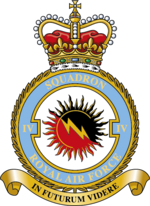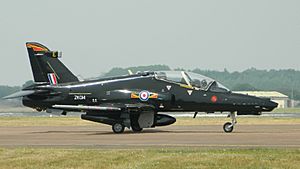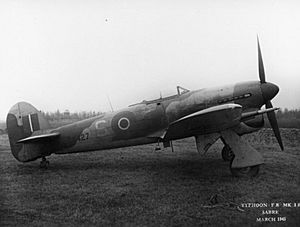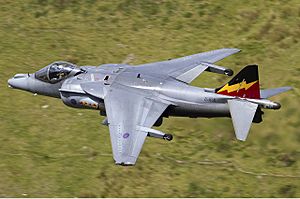No. 4 Squadron RAF facts for kids
Quick facts for kids No. IV Squadron RAF |
|
|---|---|

Squadron badge
|
|
| Active | 16 September 1912 – 1 April 1918 (RFC) 1 April 1918 – 31 August 1945 (RAF) 1 September 1945 – 31 December 1960 1 January 1961 – 31 March 2010 1 April 2010 – 28 January 2011 24 November 2011 – present |
| Country | |
| Branch | |
| Type | Flying training squadron |
| Role | Advanced fast jet flying training |
| Part of | No. 4 Flying Training School RAF |
| Home station | RAF Valley |
| Motto(s) | In futurum videre (Latin for 'To see into the future') |
| Aircraft | BAE Systems Hawk T2 |
| Battle honours |
|
| Insignia | |
| Squadron badge heraldry | A sun in splendour divided per bend by a flash of lightning. Approved by King Edward VIII in May 1936. The red and black segmented sun suggests round-the-clock operations, while the lightning flash is a reference to the unit's early use of wireless telephony for artillery co-operation. |
| Squadron roundel | |
No. IV Squadron is a famous squadron of the Royal Air Force (RAF). Since November 2011, it has flown the BAE Hawk T2 jet from RAF Valley in Wales. This squadron helps train student pilots. They learn advanced flying skills and how to use weapons after they've learned to fly jet aircraft. For many years, between 1970 and 2011, No. IV Squadron used different versions of the Hawker Siddeley Harrier and British Aerospace Harrier II jets.
Contents
Squadron History: From Old Planes to Modern Jets
Starting Out: First World War Missions
No. IV Squadron began at Farnborough Airfield in 1912. It was part of the Royal Flying Corps, which was the UK's air force before the RAF. The squadron used a mix of early aircraft, like the Royal Aircraft Factory B.E.2 and Breguet Type III biplanes.
When the First World War started in 1914, the squadron's best planes went to France. Their main job was to fly reconnaissance missions. This meant they would fly over enemy lines to gather information for the British army. On August 19, 1914, Lieutenant G. W. Mapplebeck flew the squadron's first mission over France. They were looking for German cavalry near Gembloux, Belgium. Some planes stayed in England to patrol against German airships called Zeppelins.
In 1916, the squadron started using the B.E.2 aircraft for reconnaissance. During the Battle of the Somme, they flew low to track where friendly troops were. They also helped spot targets for artillery. In June 1917, they got new Royal Aircraft Factory R.E.8 planes. They used these in the Battle of Messines and the Battle of Passchendaele. A notable pilot, William Robinson Clarke, who was the first black pilot to serve for Britain, flew with this squadron. The squadron kept using the R.E.8 until the war ended in November 1918.
Between the Big Wars: New Aircraft and Roles
After the First World War, No. IV Squadron was fully ready again in 1920. They were based at Farnborough and flew Bristol F.2 Fighter planes. For a short time, some of the squadron moved to Ireland. This was during the Irish War of Independence. They helped with patrols there before returning to Farnborough.
In 1922, the squadron's planes were carried on Royal Navy aircraft carriers. They sailed to Turkey during a tense time called the Chanak crisis. In 1926, during a big strike in the UK, the squadron's planes patrolled railway lines. This was to prevent any damage.
Over the next few years, the squadron received newer aircraft. In 1929, they got Armstrong Whitworth Atlas planes. These were designed for working with the army. Then, in 1931, they switched to Hawker Audax aircraft. By 1937, they moved to RAF Odiham and got the more powerful Hawker Hector. Finally, in 1939, they started using the modern Westland Lysander monoplane.
World War II: Reconnaissance and Attack
When the Second World War began in 1939, the squadron moved to France. They were part of the British army. In May 1940, Germany invaded France. The squadron had to move bases often to avoid the advancing German forces. They returned to the UK on May 24. They had suffered heavy losses, with many aircrew and groundcrew killed or missing.
Back in the UK, they helped with coastal patrols and air-sea rescue. In 1942, the squadron's role changed. Instead of just working with the army, they became a fighter-reconnaissance unit. This meant they would fly faster, more powerful planes. They received Curtiss Tomahawk and North American Mustang aircraft. They flew low-level attack and reconnaissance missions over Europe.
In 1943, they joined the RAF Second Tactical Air Force. This force was preparing for the invasion of Europe. In 1944, they focused purely on reconnaissance. They used Mosquito PR.XVI and Spitfire PR.XI planes. They also briefly used Hawker Typhoons for low-level missions. The squadron kept its Spitfires until VE Day (Victory in Europe Day). They then moved to Germany to help survey the area for the British army. The squadron was officially stopped on August 31, 1945.
After the Wars: Jet Age and Training
The squadron quickly started up again the very next day. They took over from another squadron and were based in the Netherlands. They first flew de Havilland Vampire fighter-bombers in 1950. Then, they switched to North American Sabre jets in 1953. In 1955, they got Hawker Hunter jets. The squadron was stopped again on December 31, 1960.
But not for long! On January 1, 1961, it reformed again. They continued to fly Hunter FR.10s for low-level reconnaissance. In 1970, they started flying the Hawker-Siddeley Harrier. This was a special jet that could take off and land vertically. They flew Harriers from bases in West Germany.
The squadron used Harrier jets for many years, getting updated versions as they came out. In 1999, the squadron moved from Germany to RAF Cottesmore in the UK.
On March 31, 2010, No. IV Squadron was stopped and then reformed as a reserve squadron. They became the main training unit for Harrier pilots. However, due to a defense review in 2010, the squadron was stopped again in January 2011.
But once more, it didn't stay stopped! On November 24, 2011, it reformed by taking over from another squadron. Now, No. IV Squadron flies the BAE Hawk T2 from RAF Valley. Their job is to provide advanced tactical weapons training for new pilots.
In March 2020, the squadron was given a special honor. They earned the right to display a battle honour on their squadron standard. This was for their important role in Operation Deliberate Force in Bosnia in 1995.
Aircraft Operated by No. IV Squadron
Over its long history, No. IV Squadron has operated many different types of aircraft. Here are some of them:
- Breguet Type III
- Cody V biplane
- Avro 500
- Farman MF.11
- Voisin III
- Morane-Saulnier H
- Bristol Scout
- Martinsyde S.1
- Caudron G.III
- Royal Aircraft Factory B.E.2
- Royal Aircraft Factory R.E.8
- Bristol F.2 Fighter
- Armstrong Whitworth Atlas
- Hawker Audax
- Hawker Hector
- Westland Lysander
- Curtiss Tomahawk
- North American Mustang
- de Havilland Mosquito
- Supermarine Spitfire
- de Havilland Vampire
- North American Sabre
- Hawker Hunter
- Hawker Siddeley Harrier GR.1 GR.3 T.4
- BAE Harrier II GR5, T12, GR7 GR7A GR9
- BAE Hawk T2
Images for kids
See also
- List of Royal Air Force aircraft squadrons





